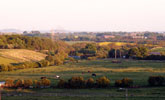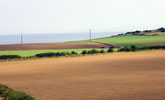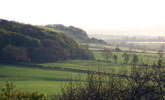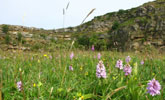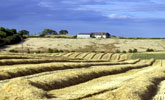East Durham Limestone Plateau
Key Characteristics
- Gently rolling low plateau dipping southwards to the Tees plain and eastward to the coast where it is incised by steep sided denes.
- Soft Permian magnesian limestones are overlain by thick glacial boulder clays.
- A low west-facing escarpment is dissected in the north by minor valleys separated by well-defined spurs.
- Varied coastal topography of low limestone cliffs and clay slopes, sandy bays and rocky headlands, despoiled in places by the tipping of colliery wastes.
- Open largely arable farmland on heavy clay soils with large fields bounded by low clipped hedges and few hedgerow trees.
- Remnants of magnesian limestone grassland on thin calcareous soils on steeper escarpment slopes and drift free ridges. Limestone plant communities in old quarries.
- Woodland cover is low. Ancient ash woods are found in steep sided limestone denes towards the coast and on the escarpment inland.
- Widespread urban development with scattered mining towns and villages becoming more concentrated towards the coast. Large industrial estates fringe the main settlements.
- Strong corridors of infrastructure in the east and west including major roads, the A1 (M) and A19, railway lines and transmission lines.
- Large limestone quarries are prominent on the escarpment. Areas of derelict or recently restored colliery land are found close to towns and villages.
- A landscape heavily influenced by development with a semi-rural or urban fringe character in places.
Description
A low upland plateau of Magnesian Limestone falling eastwards to the sea and southwards to the Tees plain and defined in the west by a prominent escarpment. The soft Permian rocks that underlie the plateau are covered in most places by a thick mantle of glacial drift but outcrop on the escarpment and coast. The escarpment is deeply divided in the north forming a spur and vale landscape, which becomes less sharply defined in the south and merges with the low eastern ridges of the Pennine fringe. The topography of the plateau is gently undulating and is deeply incised in the east by coastal denes. The coastline is one of clay crested limestone cliffs, giving way in the south to low dunes, with a foreshore of sandy beaches and rock outcrops heavily despoiled in the north by tipping of coal wastes. The heavy clay soils that cover much of the plateau support mixed, predominantly arable, farmland in an open rolling landscape of low hedges with few trees. Field patterns are fairly regular in places but more often fragmented by amalgamation into large arable fields. The shallow calcareous soils of the steeper escarpment slopes have a more pastoral emphasis and contain areas of older, more diverse, magnesian limestone grassland.
Tree cover is sparse and there is little woodland. Ancient semi-natural ash woodlands are found in the coastal denes and occasionally on escarpment spurs and valley sides together with areas of scrub.
Old agricultural villages are scattered thinly across the landscape. Buildings are of local limestone or carboniferous sandstone with roofs of slate or clay pan tile and are often set around a village green. Mining towns and villages are more widespread and increase in density towards the coast. Many were built on the site of older villages and some retain an older core. Most have a centre of 19th century terraced housing of brick or stone and slate surrounded by estates of post-war public housing. Settlement edges are often abrupt or fringed by allotment gardens, pony paddocks or industrial estates. The large new town of Peterlee lies in the south. The landscape is locally dominated by industrial land use and its associated infrastructure including major roads, railways and transmission lines, particularly in the coastal (A19) and central (A1(M)) corridors.
The landscape has been heavily influenced by coal mining both in its settlement pattern and Infrastructure, and in the substantial areas of derelict and recently claimed land in the urban fringe. The escarpment and parts of the plateau have also been affected by the quarrying of limestone. Large active and disused quarries occupy prominent sites on the escarpment. A number of older quarries that have naturally re-vegetated are managed as nature reserves.
The landscape is generally open and broad in scale although the plateau terrain rarely affords long distance views. From the higher ground of the escarpment there are panoramic views across the Wear lowlands to the Pennine fringes beyond, and south across the Tees plain to the Cleveland Hills. The landscape of the plateau has been heavily influenced by urban and industrial development and its scattered mining towns and villages and busy roads give it a semi-rural or urban fringe character in places.
View interactive map of County Character Areas
Broad Landscape Types
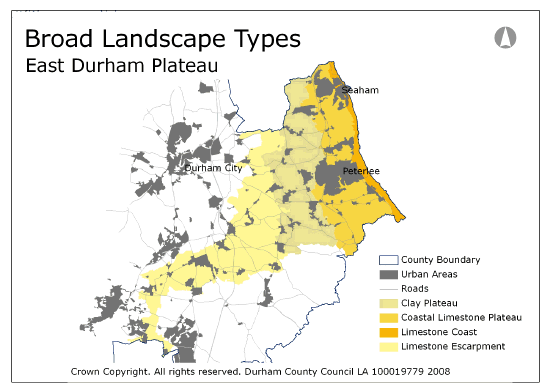
The East Durham Plateau can be broadly divided into escarpment and plateau landscapes. In the north, and to a lesser degree in the south where it merges with the eastern ridges of the Pennine fringe, the Limestone Escarpment is deeply divided by minor valleys giving rise to distinctive ‘spur and vale’ topography. In its central section it forms a more singular ridge.
East of the escarpment, on the Clay Plateau, the limestone is overlain by thick glacial drift and is rarely expressed at the surface. Towards the coast – roughly east of the A19 – it outcrops more frequently in the low rounded hills and steep-sided coastal denes of the Coastal Limestone Plateau.The Limestone Coast, with its low cliffs and dunes, is also identified as a separate landscape type, defined inland generally by the coastal railway line.
View interactive map of Broad Landscape Types


